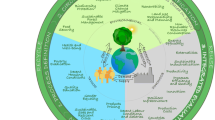Abstract
This article examines the prospects for an authentic regional architecture in the light of alternative development paradigms. It is argued that the failure of orthodox development strategies and the domination of western culture, including architecture, over non-Western cultures, is due to fundamental imbalances between northern and southern economic structures. By contrast, ecodevelopment, appropriate technology and regional architecture all represent significant devolutionary movements toward a global “eco-culture.” A cultural typology placing eco-culture in historical perspective is outlined. It is concluded that, to be fully effective, changes in development patterns in the south have to be matched by equivalent cultural changes in the North.
Similar content being viewed by others
References
Abel, C. (1993). An architect for the poor. In B. Farmer, and H. Louw (Eds.),Companion to architectural thought. London: Routledge.
Abel, C. (1991). The essential tension.Architecture and Urbanism, 250, 38, July.
Abel, C. (1990). Reciprocity, design and development.” In Rajeshwari Ghose (Ed.),Design and development in South and Southeast Asia. Center of Asian Studies, University of Hong Kong.
Abel, C. (1989). From hard to soft machines. In I. Lambot (Ed.),Norman Foster, Vol 3. Hong Kong: Watermark.
Abel, C. (1988). Model and metaphor in the design of new building types in Saudi Arabia. InTheories and Principles of Design in the Architecture of Islamic Societies. The Aga Khan Program for Islamic Architecture.
Abel, C., (1987).Transformations. Malta: Roberts Press.
Abel, C. (1986a). Regional transformations.The Architectural Review, 130(1077), November.
Abel, C., (1986b). Ditching the dinosaur sanctuary: seventeen years on. In C. Giraud et al. (Eds.),CAD and robotics in architecture and construction. London: Kogan Page.
Abel, C., (1985). Larsen’s hybrid masterpiece,The Architectural Review, 128(1061), July.
Abel, C., (1984). Living in a hybrid world, II: Built sources of Malaysian identity. In R. Langdon and N. Cross (Eds.),Design and Society, London: Design Council.
Abel C. (1982). Living in a hybrid world, I: the evolution of cultural identities in developing nations.Design Studies, 3(3), July.
Abel, C. (1969a). Ditching the dinosaur sanctuary.Architectural Design, 7(6), August.
Abel, C. (1969b). Evolutionary planning.Architectural Design, December.
Abel, C. (n.d.). An appraisal of the Aga Khan University and hospital buildings, Karachi, Pakistan.Atrium, No. 6.
Alexander, C. (1964). Notes on the Synthesis of form. Cambridge: Harvard University Press.
Ang, T.C., Hua, Y.K. (1976). Old row houses of peninsula Malaysia.Majallah Akitek, No. 2, June.
Anzorena, J. (1993). Informal housing and the barefoot architect. In B. Farmer, H. Louw, and A. Napper (Eds.),Companion to architectural thought, London: Routledge.
Bartelmus, P. (1986).Environment and development. Boston: Allen and Unwin.
Bernstein H. (ed.) (1973).Underdevelopment and development. Harmondsworth: Penguin Books.
Bookchin, M. (1980).Toward an ecological society. Montreal: Black Rose Books.
Clark, W. (1976). Big and/or little? Search is on for the right technology.Smithsonian Magazine, 55.
Clements, K.P. (1980). From right to left in development theory.Occasional Paper No. 61, Institute of Southeast Asian Studies.
Consumers’ Association of Pengang. (Eds.). (1982).Development and the Environmental Crisis, the Consumers’ Association of Penang, Penang.
Darrow, K., Saxenian, M. (1986).Appropriate Technology Sourcebook, Volunteers in Asia, Stanford.
Fathy, H. (1973.Architecture for the Poor. Chicago: The University of Chicago Press.
Frank, A.G. (1978). Superexploitation in the third world.Two Thirds, 1(2), fall.
Galbraith, K. (1967).The new industrial state. New York: New American Library.
Galtung, J., Heiestad, T., Ruge, E. (1979). On the decline and fall of empires: The Roman Empire and Western imperialism compared. United Nations University Project on Goals Processes and Indicators of Development (GPID), Human and Social Development Programme (HSDP), Working Paper Series No. HSDRGPID-1/UNUP-53, Tokyo: The United Nations University.
George, S. (1988).A fate worse than debt, Harmondsworth: Penguin Books.
Ghosh, P.K. (Ed.) (1984).Urban development in the third world. Westport: Greenwood Press.
Holod R., and Rastorfer D. (Eds.). (1983).Architecture and community. New York: Islamic Publications Ltd., 211–221.
Kelbaugh, D. (Ed.). (1989).The pedestrian pocket book. Princeton: Architectural Press.
King, A.D. (1976).Colonial urban development. London: Routledge and Kegan Paul.
Lowder, S. (1986).Inside Third World cities. London: Croom Helm.
McGee, T.G. (1971).The urbanization process in the Third World. London: G. Bell and Sons Ltd.
Oliver, P. (1980).Shelter, sign and symbol. New York: Harry N. Abrams.
Rapaport A. (1969).House form and culture. Englewood: Prentice-Hall.
Report on the Sustainable City Forum. (1992).Streetwise, no. 11, summer.
Rist, G. (1979). Development theories in the social looking-glass: some reflections from theories to “development”,HSDRGPID-4/UNUP-56, Tokyo: United Nations University.
School, N. A climate of dangerous uncertainty.The Independent, Monday, 25 May 1992, p. 15.
Trainer, T. (1989).Developed to death. London: Green Print.
UNEP/GC/80. (n.d.). United Nations Environment Program, Nairobi, 15 January, p. 1.
Valaskakis, K., Sindell, P.S., Graham Smith, J., & Fitzpatrick-Martin, I. (1979).The conserver society, New York: Harper and Row.
Vale, B., & Vale, R. (1991).Green architecture, London: Thames and Hudson.
Vincent, G., Peacock J. (1985).The automated building. London: The Architectural Press
Ward, P. (Ed.) (1982).Self-help housing. London: Mansell Publishing Ltd.
Yuan L.J. (1987).The malay house. Penang: Institute Masyarakat.
Author information
Authors and Affiliations
Additional information
He has taught at universities in many parts of the world, including North and South America, the Far East and the Middle East. He has written on the theory and criticism of contemporary architecture in both the developed and developing world. His books includeTransformations, Roberts Press, Malta (1987), andRenault Centre: Norman Foster, Architecture Design and Technology Press (1991).
Rights and permissions
About this article
Cite this article
Abel, C. Eco-culture, development, and architecture. Knowledge and Policy 6, 10–28 (1993). https://doi.org/10.1007/BF02696280
Issue Date:
DOI: https://doi.org/10.1007/BF02696280




